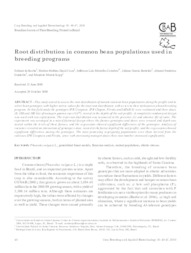Root distribution in common bean populations used in breeding programs.
Root distribution in common bean populations used in breeding programs.
Autoria: ROCHA, F. da; COAN, M. M. D.; COIMBRA, J. L. M.; BERTOLDO, J. G.; GUIDOLIN, A. F.; KOPP, M. M.
Resumo: This study aimed to assess the root distribution of mutant common bean populations along the profile and to select bean genotypes with higher metric values for the trait root distribution, with a view to their inclusion in a bean breeding program. In this field study the genotypes IPR Uirapuru, IPR Chopim, Pérola and IAPAR 81 were evaluated and three doses (0, 100 and 200 Gy) of mutagen gamma rays (Co60), nested in the depths of the soil profile. A completely randomized design was used with two replications. The trait root distribution was measured in the presence (1) and absence (0) of roots. The experiment was arranged in a mixed factorial design where the factors genotypes and doses were crossed and depth was nested within the levels of these factors, and the regressions showed significant differences of the genotypes. Analysis of variance revealed an interaction of genotype x dose, nested in the factor depth of the soil profile, and the regressions showed significant differences among the genotypes. The most promising segregating populations were those derived from the cultivars IPR Uirapuru and Pérola, since with increasing mutagen doses their root number increased significantly.
Ano de publicação: 2010
Tipo de publicação: Artigo de periódico
Unidade: Embrapa Gado de Leite
Palavras-chave: Abiotic stress, Abiotic stresses, Análise bayesiana, Bayesian analysis, Distribuição de raiz em feijão, Estresses abióticos, Feijão, Generalized linear models, Modelo linear, Modelos lineares generalizados, Mutant populations, Phaseolus Vulgaris, Phaseolus vulgaris L, Populações mutantes
Observações
1 - Por padrão são exibidas publicações dos últimos 20 anos. Para encontrar publicações mais antigas, configure o filtro ano de publicação, colocando o ano a partir do qual você deseja encontrar publicações. O filtro está na coluna da esquerda na busca acima.
2 - Para ler algumas publicações da Embrapa (apenas as que estão em formato ePub), é necessário ter, no celular ou computador, um desses softwares gratuitos. Sistemas Android: Google Play Livros; IOS: iBooks; Windows e Linux: software Calibre.
Acesse outras publicações
Acesse a Base de Dados da Pesquisa Agropecuária (BDPA) para consultar o acervo completo das bibliotecas da Embrapa.

